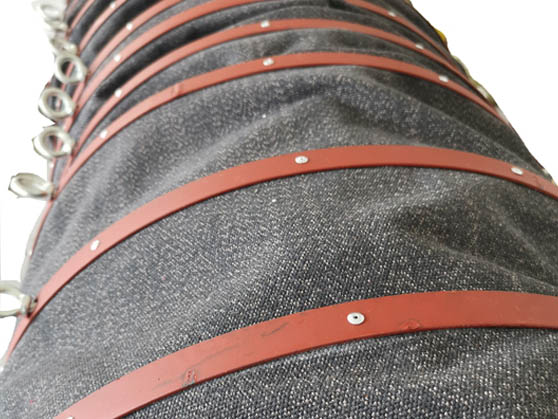The iron ring telescopic bellow is a flexible connecting device used in the loading and unloading of bulk materials (such as セメント, fly ash, mineral powder, 穀類, etc.). Supported by internal metal iron rings, it provides telescopic movement, bending, and sealing, effectively preventing dust leakage while accommodating the lifting and tilting motions of bulk loaders.
Key Features
High Flexibility & Telescopic Performance
Made of multi-layer wear-resistant fabric (e.g., polyester, silicone-coated cloth), offering excellent flexibility and free telescoping to adapt to displacement between bulk loaders and tankers.
Reinforced with internal metal iron rings (galvanized steel or stainless steel) to maintain shape and prevent collapse.
Superior Sealing
Flange connections ensure tight sealing with bulk loaders and tankers, secured by clamps to eliminate dust leakage (complies with environmental standards).
Abrasion & Corrosion Resistant
Optional anti-static or high-temperature coatings (e.g., silicone) for harsh environments (heat, moisture, corrosive materials).
簡単な取り付け
Flange design allows quick assembly/disassembly, reducing maintenance costs.
幅広い適用性
Ideal for bulk loaders, tankers, pneumatic conveying systems in cement plants, 発電所, chemical plants, grain storage, etc.
Technical Specifications
素材: Polyester + silicone coating / anti-static fabric / high-temperature resistant fiber
Iron Ring Material: Galvanized steel / stainless steel (304/316)
Diameter Range: DN150–DN600 (customizable)
動作温度: -30°C to +200°C (material-dependent)
圧力: Atmospheric or slight negative pressure
the comparison between Aluminum Alloy Ring そして Iron Ring telescopic ベロー
1. Material Differences
Aluminum Alloy Ring fabric Bellow
Frame Material: Rings or spiral rings made of aluminum alloy (e.g., 6061, 6063).
特徴: Lightweight, excellent corrosion resistance (ideal for humid/chemical environments), but lower heat resistance (typically ≤200°C).
アプリケーション: Food, pharmaceutical, and electronics industries where weight and corrosion resistance are critical.
Iron Ring Telescopic Bellow
Frame Material: Flat steel flanges (galvanized or stainless steel).
特徴: High strength, superior heat resistance (galvanized steel ≤300°C, stainless steel ≤500°C), but heavier weight. Galvanized steel may rust in humid conditions.
アプリケーション: High-temperature exhaust, industrial dust collection (e.g., welding fumes, boiler emissions) in heavy industries.
2. Structural Design
Aluminum Alloy Rings
Typically spiral or spaced circular rings embedded internally, offering flexible multi-directional movement.
Wider ring spacing reduces airflow resistance but weaker against negative pressure (prone to collapsing).
Iron Rings
Tightly arranged flat flanges wrapped in abrasion-resistant fabric, providing rigid support and high negative pressure resistance.
Larger bending radius, suitable for linear pipelines or minor displacements, but less adaptable to complex bends.
3. Performance Comparison
特徴 | Aluminum Alloy Ring fabric ベロー | Iron Ring fabric ベロー |
重量 | Light | Heavy |
耐食性 | Excellent (anti-rust/chemical) | Moderate (galvanized needs maintenance) |
Heat Resistance | Medium (≤200°C) | High (stainless steel up to 500°C) |
圧力抵抗 | Low | High (suits high-pressure/vacuum systems) |
柔軟性 | High (multi-directional) | Medium (axial movement preferred) |
コスト | Higher (aluminum price) | Lower (galvanized steel is economical) |
4. Selection Guide
Choose Aluminum Alloy Rings のために
Lightweight needs, frequent movement, or corrosive environments (e.g., chemical plants, cleanrooms).
Lower temperatures and high sealing requirements.
選択 Iron Rings のために
High-temperature, high-pressure, or vacuum conditions (e.g., boilers, metallurgy, mining).
Budget constraints with controlled humidity (galvanized requires periodic maintenance).
5. Additional Notes
Fabric Options: Both types can use various linings (e.g., silicone fiberglass, PTFE-coated fabric) based on medium compatibility (abrasion/chemical resistance).
Installation: Steel flanges often require bolted flanges, while aluminum rings allow quick clamp mounting.
For optimal performance and lifespan, evaluate temperature, pressure, medium, and displacement requirements when selecting materials and structures.


